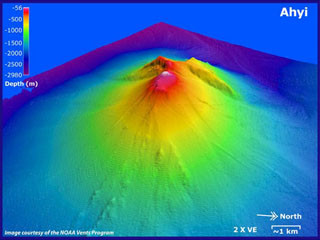Report on Ahyi (United States) — 17 January-23 January 2024
Smithsonian Institution / US Geological Survey
Weekly Volcanic Activity Report, 17 January-23 January 2024
Managing Editor: Sally Sennert.
Please cite this report as:
Global Volcanism Program, 2024. Report on Ahyi (United States) (Sennert, S, ed.). Weekly Volcanic Activity Report, 17 January-23 January 2024. Smithsonian Institution and US Geological Survey.
Ahyi
United States
20.42°N, 145.03°E; summit elev. -75 m
All times are local (unless otherwise noted)
Signs of unrest at Ahyi Seamount continued. Plumes of discolored water extending 4-4.5 km from the summit area were identified in satellite images during 21-23 January. No volcanic activity was identified in data from underwater pressure sensors near Wake Island (about 2,270 km E of Ahyi). The Aviation Color Code remained at Yellow (the second lowest level on a four-color scale) and the Volcano Alert Level remained at Advisory (the second lowest level on a four-level scale).
Geological Summary. Ahyi seamount is a large conical submarine volcano that rises to within 75 m of the ocean surface ~18 km SE of the island of Farallon de Pajaros in the northern Marianas. Water discoloration has been observed there, and in 1979 the crew of a fishing boat felt shocks over the summit area, followed by upwelling of sulfur-bearing water. On 24-25 April 2001 an explosive eruption was detected seismically by a station on Rangiroa Atoll, Tuamotu Archipelago. The event was well constrained (+/- 15 km) at a location near the southern base of Ahyi. An eruption in April-May 2014 was detected by NOAA divers, hydroacoustic sensors, and seismic stations.
Source: US Geological Survey

